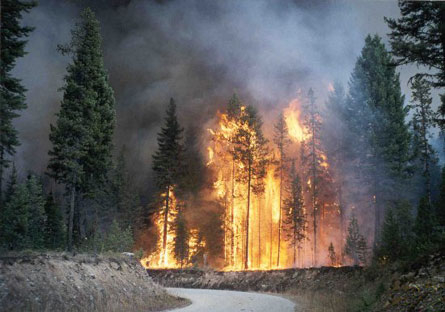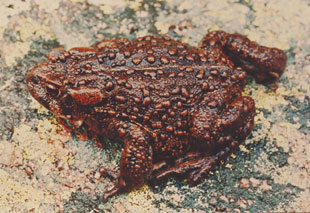Fire Toads
Air Date: Week of July 18, 2003
Two years ago, a lightning strike set off a wildfire that swept through thousands of acres in Montana, and destroyed nearly a third of the landscape in Glacier National Park. But as Sandy Hausman reports, the fire may have helped out one little forest dweller.
Transcript
KNOY: It started as a lightning strike near Whitefish Divide, but by the time it was finally contained a month later, a huge wildfire had destroyed more than 70,000 acres of forest land in Montana - nearly a third of it in Glacier National Park. Two years since that fire charred the landscape, the forest is showing dramatic signs of recovery. And, as Sandy Hausman reports, experts even think the blaze may have helped out one of the park's smaller residents.
[CONSTRUCTION SOUNDS]

The 2001 Moose Fire that burned Glacier National Park and aided the toad resurgence.
(Photo: National Park Service/US Forest Service)
HAUSMAN: Stan Star works for Glacier National Park – grading and plowing the roads. After forest fires, he has seen the thin black stalks that remain where wide tree trunks once stood. Each time, he has marveled as nature began its comeback with wildflowers, grasses and saplings crowding the forest floor. But nothing has surprised him quite so much as the revival of a rare woodland creature.
STAR: I was grading the road through the inside from Logging to Dutch Creek. And as I proceeded through this area I noticed the ground started to move and jump and hop and so I thought, “Oh, I'm hallucinating!” I've seen a lot of weird and strange things but that was one of the stranger ones.
[CELL PHONE RING]
HAUSMAN: After a closer look, Star got on his cell phone to report that thousands of tiny toads – about the size of a thumbnail – were making their way from ponds in Sullivan Meadow, across the road, into the forest where they would spend the winter under tree stumps, in root channels or rodent burrows.
CORN: There are some species of frogs in North America that actually freeze solid over the winter, but toads don't do that, so they have to find a place where they're not gonna dry out and where they're not gonna freeze.
 Boreal toad (Photo: Stephen Corn, Courtesy of USGS)
HAUSMAN: Steve Corn is a zoologist with the U.S. Geological Survey in Missoula, Montana. He got three calls that day from excited park scientists who said the tiny amphibians were boreal toads. Before the fire, survey teams found this creature in less than five percent of a thousand wetlands at Glacier. They weren’t sure why the numbers were so low, but now these toads were so numerous that park officials decided to close the road. Boreal toad (Photo: Stephen Corn, Courtesy of USGS)
HAUSMAN: Steve Corn is a zoologist with the U.S. Geological Survey in Missoula, Montana. He got three calls that day from excited park scientists who said the tiny amphibians were boreal toads. Before the fire, survey teams found this creature in less than five percent of a thousand wetlands at Glacier. They weren’t sure why the numbers were so low, but now these toads were so numerous that park officials decided to close the road.
CORN: I was quite excited about it. It was really fun to get some good news for a change. Here's a population that's doing so well that we have to close a road. That's been pretty rare in the west in the last decade or so. HAUSMAN: After the initial excitement, Corn began to wonder where these toads had come from and why they had appeared now. He theorized that like some plants that need fire to reproduce, some animals might also benefit from a blaze. CORN: The length of time they spend as eggs and tadpoles is hugely dependent on water temperature. The boreal toads lay their eggs in the shallowest water they can find, typically. The warmer they are, the faster they develop. And the sooner they get out, the better they are able to survive the winter, because if they can put on a little weight, they'll likely survive a little better over winter. HAUSMAN: Corn's colleague Blake Hossack says the fire cleared the forest canopy and made way for sunlight. Hossack: Really cleaned it out. It used to be pretty unpleasant to bushwhack through this area, and now it's very easy. HAUSMAN: He and other scientists reason that the warmer woodland ponds are a better place for tadpoles, and they're relieved that the Park Service agreed to keep traffic away – further improving the odds for survival. Frankly, Hossack didn't expect such consideration. Hossack: Amphibians tend not to be the highest priority species in the Northern Rockies. Popularity has gained in part, I think, due to beer commercials. HAUSMAN: Not only have amphibians proven effective in selling Budweiser beer on TV, Corn says they play a critical role in a woodland ecosystem. In the California Sierras, for example, a decline in the toad population could explain a decrease in the number of snakes that feed on toads and, in turn, a drop in the population of hawks and owls that feed on snakes. He believes the revival of boreal toads in Montana may support the argument already advanced by many – that total suppression of fires does not serve the long-term needs of forest plants and animals. CORN: It's more evidence that re-establishing a more natural fire regime in these forests will benefit the ecosystem as a whole. HAUSMAN: If the canopy is burned away from time to time, he says the boreal toad could make an even more significant comeback, with a single female laying up to 20,000 eggs each year. That means Stan Star could be witnessing another moving road this summer. And when last year's crop of toadlets reaches maturity in 2005, visitors could be hearing something missing from Glacier for years. [BOREAL TOAD CALLS] HAUSMAN: Crowds of breeding boreal males calling softly to define and defend their turf. For Living on Earth, I’m Sandy Hausman in Glacier National Park. [MUSIC: Rob Ickes “Dwight’s Blues” Slide City Rounder (1999)] Living on Earth wants to hear from you!Living on Earth Newsletter [Click here]
Donate to Living on Earth! NewsletterLiving on Earth offers a weekly delivery of the show's rundown to your mailbox. Sign up for our newsletter today!
|





